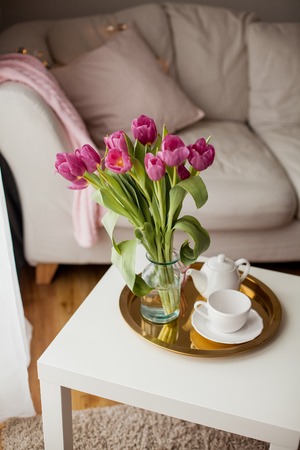Introduction to Feng Shui in British Homes
Feng Shui, an ancient Chinese practice centred on the harmonious arrangement of space, has found a unique resonance within British living rooms. As British households continue to embrace global influences while holding steadfast to their own design traditions, the adaptation of Feng Shui principles becomes both a creative and cultural exploration. In Britain, the living room is often regarded as the heart of the home—a place where families gather, entertain guests, and unwind after a long day. The way these interiors are styled not only reflects personal taste but also subtly conveys broader cultural sensibilities. By weaving together traditional Feng Shui concepts with quintessentially British aesthetics—think period fireplaces, bay windows, and a fondness for both heritage and contemporary touches—homeowners are discovering new ways to enhance comfort and wellbeing. This introduction sets the stage for understanding how colour choices within these spaces are more than mere decoration; they become deliberate tools for fostering balance, positivity, and connection in everyday life.
2. Fundamental Principles of Colour in Feng Shui
At the heart of Feng Shui lies the belief that colour is far more than mere decoration—it serves as a conduit for energy (Qi), shaping the emotional and energetic climate of our living spaces. Classic Feng Shui theory, rooted in ancient Chinese philosophy, assigns each colour to one of the five elements: Wood, Fire, Earth, Metal, and Water. These elements interact dynamically to foster balance and harmony within the home. In a British context, where seasonal light and architectural styles differ from East Asian environments, careful consideration must be given to how these colours are integrated into living rooms.
The Five Elements and Their Colours
| Element | Associated Colour(s) | Emotional Influence | Typical British Application |
|---|---|---|---|
| Wood | Green, Brown | Growth, Vitality, Renewal | Olive green accents; natural wood finishes |
| Fire | Red, Orange, Pink | Passion, Energy, Warmth | Deep red cushions; terracotta feature walls |
| Earth | Yellow, Beige, Ochre | Stability, Comfort, Nourishment | Creamy paints; muted yellow throws |
| Metal | White, Grey, Metallics | Clarity, Precision, Calmness | Pewter or brass accessories; pale grey walls |
| Water | Blue, Black | Tranquillity, Wisdom, Depth | Navy blue rugs; charcoal accent chairs |
The Role of Light and Climate in Colour Selection
The often cloudy or overcast British weather means that natural light is precious. Lighter hues such as soft whites or pastels can help reflect available daylight and lift the mood within a space. Meanwhile, deep or muted shades like forest green or navy blue echo the British landscape and bring a sense of familiarity and grounding.
The Balance Between Tradition and Modernity
While traditional Feng Shui guidelines provide a foundation for choosing colours based on desired energies—calm for relaxation zones or vibrancy for social areas—modern British homes frequently blend these principles with contemporary trends. For instance, pairing classic earth tones with sleek metallic finishes creates both harmony and visual interest without sacrificing cultural relevance.
![]()
3. Popular Colour Schemes in British Living Rooms
When considering the interplay between traditional British interior design and Feng Shui principles, colour selection emerges as a nuanced art. British living rooms are renowned for their preference toward muted tones and heritage hues, both of which evoke a sense of comfort, history, and understated elegance. Soft greys, sage greens, dusky blues, and warm neutrals such as oatmeal or taupe often dominate the palette. These shades not only reflect the gentle, often overcast British light but also pay homage to the country’s rich architectural past—from Victorian terraces to Georgian townhouses.
Feng Shui, with its roots in balancing energy and promoting harmony within a space, offers guidance that dovetails neatly with these classic British choices. For instance, earth tones—so favoured in British décor—are believed in Feng Shui to foster stability and nourishment. Greys and blues connect to the water element, encouraging calm and clarity, while subtle greens represent growth and renewal. Heritage reds or deep burgundies, though used sparingly, can introduce a warming fire element without overwhelming the room’s tranquil ambiance.
In essence, the understated palettes beloved in Britain align well with Feng Shui advice to avoid harsh contrasts or overly stimulating colours in communal areas like living rooms. Instead, both traditions advocate for a harmonious blend of tones that create an inviting yet balanced environment—a testament to how cultural taste can beautifully coexist with ancient wisdom.
4. Cultural Nuances: British Interpretations of Feng Shui Colours
When applying Feng Shui principles to British living rooms, it is crucial to consider the unique lens of British culture and history. While traditional Feng Shui associates specific colours with distinct energies and elements, the British approach often intertwines these ideas with local heritage, architectural trends, and emotional associations rooted in national experience. For example, whereas red is a symbol of good fortune and prosperity in traditional Chinese Feng Shui, in Britain it may evoke images of classic double-decker buses or historic telephone boxes—infusing the space with a sense of nostalgia or patriotism rather than wealth alone.
Historic Influences on Colour Choices
The legacy of the Victorian era and the Arts and Crafts movement continues to influence British interior palettes, favouring deep greens, muted blues, and earthy tones. These shades are interpreted through a modern Feng Shui lens as stabilising and grounding, aligning harmoniously with Britains often grey climate by creating comfort and warmth indoors.
Table: Traditional vs British Feng Shui Colour Meanings
| Colour | Traditional Feng Shui Meaning | British Interpretation/Adaptation |
|---|---|---|
| Red | Luck, Prosperity | Nostalgia, Warmth, Heritage (e.g., red brickwork) |
| Green | Growth, Vitality | Connection to Landscape, Calm (inspired by British countryside) |
| Blue | Tranquillity, Wisdom | Sophistication, Reflection (echoing Georgian interiors) |
| Yellow/Gold | Happiness, Wealth | Coziness, Cheer (reminiscent of English sunshine or daffodils) |
| White/Cream | Purity, Clarity | Tastefulness, Light Enhancement (combating overcast weather) |
Local Adaptations in Practice
British homes frequently adapt Feng Shui guidance by blending Asian philosophy with their own preferences for comfort and practicality. For instance, instead of vivid primary colours seen in many Asian interiors, softer pastels or heritage tones are favoured to maintain the understated elegance typical of British décor. Similarly, colour choices might be influenced by seasonal changes; warmer hues are used to counter winter gloom while lighter shades brighten rooms during summer months. Ultimately, these cultural nuances shape a uniquely British approach to Feng Shui—one that respects tradition yet embraces local identity.
5. Practical Tips for Applying Feng Shui Colour Principles
When incorporating Feng Shui colour principles into a British living room, it is essential to balance tradition with the distinctive qualities of local homes. Begin by observing your room’s natural light: north-facing rooms in Britain often receive cooler, softer daylight, making them ideally suited for warm hues such as creamy yellows, soft terracottas, or gentle blush tones. These colours can help offset any sense of chill and create a welcoming atmosphere.
Consider Regional Trends and Heritage
British interiors often favour understated elegance, so opt for muted palettes inspired by the countryside—sage greens, dusky blues, and subtle greys are both calming and on-trend. For period properties or those seeking classic charm, deep forest greens and rich burgundies can echo historic British style while supporting Feng Shui’s grounding elements.
Layering Colours Thoughtfully
Combine colours by layering textiles and accessories—think throws, cushions, and curtains—in complementary shades. For instance, pair a neutral sofa with accent cushions in harmonious earth tones or metallics for a touch of modern vibrancy. This approach allows flexibility if you wish to update the look seasonally or according to changing Feng Shui needs.
Lifestyle Considerations
Your living room should reflect how you use the space. If it’s a family hub, introduce playful pops of colour through art or decorative objects to energise the room without overwhelming it. If relaxation is paramount, maintain a palette that soothes—soft blues and greens promote calmness and are particularly suitable for the British climate.
Mindful Use of Colour Placement
Apply the Bagua map to guide where specific colours might enhance your living room’s energy flow. Place vibrant reds or oranges in areas associated with fame or relationships, but use them sparingly as accents to avoid overpowering the space. Always ensure that each colour choice feels harmonious within your home’s unique character and context.
6. Case Studies: British Living Rooms Reimagined
To truly understand the impact of colour choices in British living room Feng Shui, let us explore a series of illustrative case studies that highlight how various palettes can shape both atmosphere and well-being. These examples, rooted in local culture and sensibilities, showcase the delicate balance between tradition and modern comfort.
Case Study One: The Classic Victorian Terrace
In a typical Victorian terrace house in London, the owners chose a palette of deep forest green paired with warm neutrals. This approach, inspired by nature and heritage, offers a calming backdrop while respecting traditional architecture. According to Feng Shui principles, green encourages renewal and health, which is reflected in the harmonious family interactions reported by the residents. The addition of brass accents and soft beige textiles brings warmth, echoing the British penchant for understated elegance.
Case Study Two: Contemporary Countryside Cottage
A young couple in the Cotswolds opted for a soothing combination of duck egg blue and pale grey. This fresh take on rural charm creates an airy, tranquil living space that aligns with both modern taste and Feng Shui ideals of serenity. Blue hues are believed to promote peace and clarity—qualities highly valued in the British countryside lifestyle. Guests often comment on the light, uplifting feel upon entering this cottage retreat.
Case Study Three: Urban Flat with Bold Accents
In Manchester, a city centre flat owned by a creative professional features a predominantly white scheme punctuated by vibrant red cushions and artwork. In Feng Shui, red is an energising colour associated with luck and vitality. Here, it serves as a dynamic focal point without overwhelming the senses—a nod to urban vibrancy balanced with British restraint. Friends say this living room feels both stimulating and welcoming, ideal for lively gatherings or quiet evenings alike.
Case Study Four: Minimalist New-Build Home
A family in Surrey embraced minimalism with shades of soft taupe and sage green throughout their new-build living room. These gentle colours encourage relaxation and reflect natural light beautifully—a practical consideration given Britain’s often grey skies. Following Feng Shui guidance, clutter is kept to a minimum, enhancing both flow and mental clarity for all who use the space.
Reflections on Local Preferences
Across these case studies, it is clear that British living rooms benefit from thoughtfully chosen colour schemes that blend cultural tradition with personal well-being. Whether leaning towards heritage tones or contemporary pastels, each approach demonstrates how mindful colour choices can elevate both mood and harmony in the home—proving that Feng Shui is as relevant in Britain today as ever before.
7. Conclusion: Cultivating Harmony through Colour in British Living Spaces
In summary, the mindful application of colour choices—steeped in Feng Shui principles yet thoughtfully adapted to the character of British living rooms—can significantly enhance both comfort and harmony. Selecting colours is far more than an aesthetic exercise; it is a purposeful act that influences mood, energy flow, and the overall sense of wellbeing within the home. By embracing a palette that balances calming neutrals with invigorating accents, homeowners can foster a sanctuary that feels welcoming throughout Britain’s ever-changing seasons. Gentle greys and warm creams evoke tranquillity and timelessness, while touches of green or blue encourage positive energy and connection to nature—an especially valued quality in urban or suburban settings. Ultimately, integrating Feng Shui wisdom with local sensibilities empowers residents to craft living spaces where balance, positivity, and relaxation flourish, proving that thoughtful colour curation remains as relevant to British interiors today as it was in ancient tradition.


